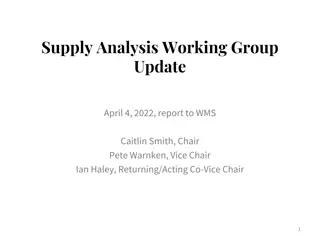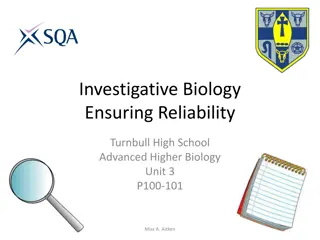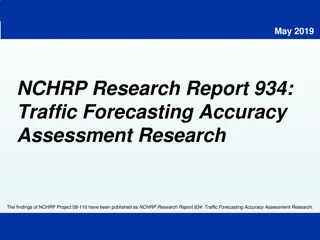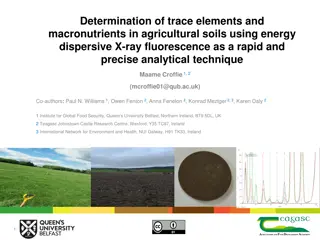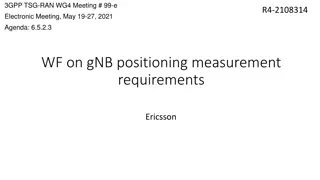Interactive Web-Based Shiny Apps for Meta-Analysis of Diagnostic Test Accuracy
Explore interactive Shiny apps presented by Nicola Cooper and team for conducting meta-analysis of diagnostic test accuracy data with a point-and-click interface. Find educational primers, principles, and tools to enhance evidence synthesis methods and visualization in healthcare.
2 views • 22 slides
Accuracy of Digital Impressions for Implant-Supported Fixed Dental Prostheses
The study presented by Dr. Roma Pandit explores the accuracy of digital impressions for three-unit and four-unit implant-supported fixed dental prostheses using a novel device. Digital impressions offer advantages over conventional methods, but challenges exist in scanning edentulous areas accuratel
0 views • 13 slides
Understanding Instrument Types and Performance Characteristics
This content discusses different types of instruments, including active and passive, null-type and deflection-type, analog and digital, as well as smart and non-smart instruments. It delves into the static characteristics of instruments such as accuracy, precision, tolerance, linearity, and sensitiv
2 views • 39 slides
Managing State School Aid Application (ASSA) for Increased Accuracy
The process for the Application for State School Aid (ASSA) involves submitting data accurately by reviewing and correcting NJ SMART district enrollment reports. District administrators must ensure the correctness of preloaded data in ASSA for final certification. Important guidelines include resolv
0 views • 33 slides
Comprehensive Cost Management Training Objectives
This detailed training agenda outlines a comprehensive program focusing on cost management, including an overview of cost management importance, cost object definition, cost assignment, analysis, and reporting. It covers topics such as understanding cost models, cost allocations, various types of an
2 views • 41 slides
Understanding Mechanisation in Offices: Objectives, Advantages, and Disadvantages
Mechanisation in office work aims to enhance efficiency, reduce monotony, and improve accuracy by introducing machines and equipment. The objectives of office mechanisation include saving labour and time, ensuring accuracy, and reducing errors. Advantages include quality work output, low operating c
2 views • 18 slides
Machine Learning for Predicting Path-Based Slack in Timing Analysis
Utilizing machine learning to forecast path-based slack in graph-based timing analysis offers a solution for optimizing power and area efficiency in the design process. The Static Timing Analysis incorporates accurate path-based analysis (PBA) and fast graph-based analysis (GBA) to estimate transiti
1 views • 31 slides
Rocket Trades - Innovative Trading Strategy for Enhanced Accuracy
Rocket Trades is a Bengaluru-based firm established in 2016, offering a proprietary trading strategy focused on futures swing and directional trading in various financial instruments. Their unique approach combines technical data, fundamental analysis, and macro sentiment to capture market movements
0 views • 23 slides
Supply Analysis WG Update & Project Success Factor Analysis
The Supply Analysis Working Group provides updates on mid-term load forecasts using different weather models. The report highlights how weather unpredictability affects forecast accuracy. Additionally, the Planned Project Success Factor Analysis evaluates success rates and development cycle trends f
0 views • 13 slides
Exploring Length and Area Concepts in Year 7 Maths
Delve into the world of measurements, accuracy limits, and area calculations in Year 7 Math. Learn about the accuracy of measurements, limits of accuracy, calculating the area of shapes, converting units of area, and investigating the area of triangles. Explore practical examples and understand the
0 views • 20 slides
Evolution of ASPRS Positional Accuracy Standards for Geospatial Data
New technological advancements have prompted the need for updated ASPRS positional accuracy standards for digital geospatial data. Legacy standards from the 1990s are no longer sufficient given the shift towards modern mapping technologies. The new era of mapping involves factors like camera calibra
0 views • 21 slides
Enhancing Reading Fluency in K-3 Literacy: Strategies and Techniques
Educators will explore strategies to improve student fluency in reading, focusing on automaticity, rate, accuracy, and prosody. Reading fluency acts as a bridge between word recognition and text comprehension, with four key components: automaticity, rate, accuracy, and prosody. Techniques such as sp
0 views • 20 slides
Diagnostic Test Accuracy Study: Design and Implementation
This content delves into the pathway of a diagnostic test from development to clinical application, focusing on the basic concepts of diagnostic test accuracy, study design, the 2x2 table, and key terminology. It discusses the importance of study design in assessing diagnostic accuracy, including fa
0 views • 16 slides
Understanding Hypothesis Evaluation in Machine Learning
Evaluating hypotheses in machine learning is crucial for assessing accuracy and making informed decisions. This process involves estimating hypothesis accuracy, sampling theory basics, deriving confidence intervals, comparing learning algorithms, and more. Motivated by questions about accuracy estim
0 views • 26 slides
Understanding Precision, Accuracy, and Reliability in Investigative Biology
Precision, accuracy, and replicates play crucial roles in ensuring reliable results in investigative biology experiments. Precision refers to the closeness of measurements, accuracy to how close they are to the actual value. Replicates involve multiple measurements within the same experiment or repe
0 views • 6 slides
NCHRP Research Report 934: Traffic Forecasting Accuracy Assessment Research
The NCHRP Research Report 934 focuses on analyzing and improving the accuracy, reliability, and utility of project-level traffic forecasts in the U.S. The study aims to address the significant knowledge gap in travel demand modeling related to urban road traffic forecasts. Key objectives include ass
0 views • 24 slides
Understanding Convolutional Neural Networks: Architectural Characterizations for Accuracy Inference
This presentation by Duc Hoang from Rhodes College explores inferring the accuracy of Convolutional Neural Networks (CNNs) based on their architectural characterizations. The talk covers the MINERvA experiment, deep learning concepts including CNNs, and the significance of predicting CNN accuracy be
0 views • 21 slides
Real-Time Mesoscale Analysis: Enhancements and Future Plans
RTMA provides detailed hourly weather analysis for different regions with a focus on improving accuracy and capabilities. Recent upgrades in analysis resolution and new variables aim to enhance forecast verification and operational efficiency. The future of RTMA involves further development for avia
1 views • 22 slides
Rounding Numbers and Establishing Limits in Mathematical Accuracy
Performing rounding calculations to the nearest 10 and 1 decimal place, understanding limits of accuracy in measurements, analyzing potential accuracy problems in precision engineering, and exploring the concept of upper and lower bounds within mathematical contexts.
0 views • 13 slides
gNB Positioning Measurement Requirements Discussion at 3GPP TSG-RAN WG4 Meeting
Discussion at the 3GPP TSG-RAN WG4 meeting #98bis-e focused on gNB positioning measurement requirements, including beam sweeping, gNB accuracy requirements, samples for gNB accuracy, RoAoA side conditions, and SRS-RSRP measurement accuracy requirements. The meeting addressed various candidate option
1 views • 14 slides
Understanding Key Science Measurement Terms for Accuracy and Precision
Explore essential science measurement terms such as accuracy, precision, resolution, and calibration. Learn how to distinguish between accuracy and precision, understand the significance of resolution in measurements, and grasp the importance of calibration in using measuring instruments effectively
1 views • 31 slides
Exploring Measurement Challenges and Concepts in Grade Five Mathematics
Delve into a variety of measurement challenges in Grade Five mathematics, including different units, common errors, measurement components, big ideas, accuracy, precision, and the measurement process. Understand the nuances between accuracy and precision, factors affecting measurement accuracy, and
0 views • 39 slides
Advancements in Program Analysis Beyond Deductive Methods
Explore the evolution of program analysis beyond deductive methods with innovative tools like static analyzers and data-driven analysis design. Discover the challenges faced, such as undecidable analysis questions and scalability issues, and the strategies employed to address them. Learn about the s
0 views • 24 slides
Understanding Significant Figures in Mathematics and Science
Significant figures play a crucial role in maintaining accuracy and precision in mathematical and scientific calculations. They help in determining the level of accuracy of measurements and calculations by focusing on the number of significant digits and decimal places. Rounding rules are essential
0 views • 6 slides
Enhancing Load Distribution Factors for Improved Accuracy
Explore techniques to enhance load distribution factors for better accuracy, considering weather forecasts that can change daily. Tasks include utilizing Mid-Term Load Forecast models, improving error correction settings, and implementing a neural network model. The aim is to increase forecast accur
0 views • 19 slides
Accuracy-Aware Program Transformations for Energy-Efficient Computing
Explore the concept of accuracy-aware program transformations led by Sasa Misailovic and collaborators at MIT CSAIL. The research focuses on trading accuracy for energy and performance, harnessing approximate computing, and applying automated transformations in program optimization. Discover how to
0 views • 20 slides
Understanding Accuracy, Precision, and Error in Scientific Measurement
Accuracy and precision are crucial in scientific measurements. Accuracy refers to how close a measurement is to the true value, while precision reflects the consistency of repeated measurements. Understanding and calculating percent error help in evaluating the reliability of data. The difference be
0 views • 13 slides
Understanding Measurement Bounds and Accuracy
Exploring the concepts of significant figures, bounds, accuracy, and ranges in measurement. From determining the smallest and largest possible lengths to finding lower and upper bounds based on accuracy, this content focuses on practical exercises and explanations to enhance understanding. Learn how
0 views • 6 slides
Enhancing Precision and Accuracy in Trace Element Analysis Using EPMA Techniques
This research focuses on improving precision and accuracy for trace elements through advanced methods like MAN (mean atomic number) and MPB (multi-point background). By optimizing background measurements and calibration techniques, researchers aim to enhance the sensitivity and reliability of trace
0 views • 16 slides
Rapid Analysis of Soil Macronutrients Using Energy Dispersive X-ray Fluorescence
Determination of trace elements and macronutrients in agricultural soils is crucial for crop productivity. This study highlights the advantages, challenges, and objectives of using energy dispersive X-ray fluorescence for rapid and precise analysis. The method requires minimal sample preparation, co
0 views • 10 slides
Introduction to Static Analysis in C.K. Chen's Presentation
Explore the fundamentals of static analysis in C.K. Chen's presentation, covering topics such as common tools in Linux, disassembly, reverse assembly, and tips for static analysis. Discover how static analysis can be used to analyze malware without execution and learn about the information that can
0 views • 54 slides
Industrial, Microbiological & Biochemical Analysis - Course Overview by Dr. Anant B. Kanagare
Dr. Anant B. Kanagare, an Assistant Professor at Deogiri College, Aurangabad, presents a comprehensive course on Industrial, Microbiological, and Biochemical Analysis (Course Code ACH502). The course covers topics such as Industrial Analysis, Microbiological Analysis, and Biochemical Analysis. Dr. K
0 views • 16 slides
Understanding Precision and Accuracy in GPS Data
Precision and accuracy play vital roles in interpreting GPS data effectively. Precision refers to how finely a value is described, while accuracy indicates the potential error in a reading. The content also highlights the significance of GPS data from phones, GPS precision in different decimal place
0 views • 25 slides
Benefits of Probabilistic Static Analysis for Improving Program Analysis
Probabilistic static analysis offers a novel approach to enhancing the accuracy and usefulness of program analysis results. By introducing probabilistic treatment in static analysis, uncertainties and imprecisions can be addressed, leading to more interpretable and actionable outcomes. This methodol
0 views • 11 slides
Building Progressions for Accuracy and Tactical Awareness in Sports Training
Progress through skill levels from closed to open skills, enhancing accuracy and tactical awareness. Discover the importance of perception, decision-making, and action in training squash players. Learn when to advance to the next level and how to train for accuracy effectively.
0 views • 7 slides
3GPP TSG-RAN WG4 Meeting #99-e Electronic Meeting Agenda
The 3GPP TSG-RAN WG4 meeting #99-e electronic meeting held on May 19-27, 2021 discussed gNB positioning measurement requirements, SRS-RSRP accuracy requirements, beam sweeping during gNB measurement, impact of SRS/IoT on accuracy, RF margin for SRS-RSRP, and gNB Tx accuracy requirements. The meeting
0 views • 9 slides
Statistical Tools for Method Validation in USP General Chapter 1210
In the USP General Chapter 1210, Statistical Tools for Method Validation are outlined, serving as a companion to the validation of Compendial Procedures. The chapter covers important topics like Accuracy, Precision, Linearity, LOD, LOQ, and range. It emphasizes statistical tools such as TOST, statis
0 views • 22 slides
SNAP Client Integrity and Payment Accuracy Highlights
The SNAP (Supplemental Nutrition Assistance Program) conference in Paris on March 14, 2012, covered topics such as client integrity and payment accuracy. The focus was on combating recipient fraud and ensuring accurate benefit distribution. Troubling activities like the sale of EBT cards and unexpla
0 views • 23 slides
Trade-offs in Floating Point Accumulation: Balancing Accuracy, Cost, and Performance
When designing floating point accumulation systems, achieving high throughput and accuracy presents a challenging trade-off. Inconsistent accuracy due to data dependencies can lead to significant errors in results. Strategies such as compensated summation or using extended precision adders can help
0 views • 11 slides
Feedback Information in Vivo Discussion
This discussion delves into how feedback information from analytics consumers can impact the accuracy of predictions in network status changes. Various scenarios are presented to illustrate how actions taken by consumers can affect ground truth data and subsequent calculations of accuracy. Proposals
0 views • 9 slides








